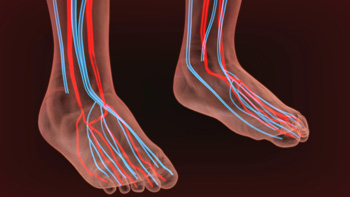Items filtered by date: April 2025
Hammertoe and Surgical Treatment Facts

Hammertoe is a deformity where one or more toes become bent at the middle joint, causing them to resemble a hammer. This condition typically develops due to muscle imbalance, foot structure, or wearing tight or ill-fitting shoes. Over time, the affected toe may become rigid and painful, often leading to difficulty walking or wearing shoes comfortably. When conservative treatments like shoe modifications, stretching, or orthotic devices do not provide relief, surgery may be considered. Surgical hammertoe correction aims to realign the toe by removing a small piece of bone or releasing tight tendons. The procedure is usually done on an outpatient basis, and recovery varies depending on the severity of the deformity. Surgery can provide significant relief and improve toe alignment. If you have a painful hammertoe, it is suggested that you consult a podiatrist who can determine if this type of foot surgery is right for you.
Foot surgery is sometimes necessary to treat a foot ailment. To learn more, contact one of our podiatrists of Nashville Family Foot Care. Our practitioners will assist you with all of your foot and ankle needs.
When Is Surgery Necessary?
Foot and ankle surgery is generally reserved for cases in which less invasive, conservative procedures have failed to alleviate the problem. Some of the cases in which surgery may be necessary include:
- Removing foot deformities like bunions and bone spurs
- Severe arthritis that has caused bone issues
- Cosmetic reconstruction
What Types of Surgery Are There?
The type of surgery you receive will depend on the nature of the problem you have. Some of the possible surgeries include:
- Bunionectomy for painful bunions
- Surgical fusion for realignment of bones
- Neuropathy decompression surgery to treat nerve damage
Benefits of Surgery
Although surgery is usually a last resort, it can provide more complete pain relief compared to non-surgical methods and may allow you to finally resume full activity.
Surgical techniques have also become increasingly sophisticated. Techniques like endoscopic surgery allow for smaller incisions and faster recovery times.
If you have any questions please feel free to contact our office located in Nashville, TN . We offer the newest diagnostic and treatment technologies for all your foot and ankle needs.
Symptoms and Causes of Poor Foot Circulation

Poor circulation in the feet can lead to several uncomfortable symptoms that may interfere with daily life. Numbness and tingling are often the first signs, creating a pins and needles sensation that can spread across the feet or toes. Swelling may also occur as blood flow becomes sluggish, causing fluid to build up in the tissues. Feet may feel unusually cold, and skin color can appear pale or bluish. Common causes of poor circulation include diabetes, peripheral artery disease, smoking, and prolonged inactivity. Wearing tight shoes or sitting for long periods may also restrict blood flow. Identifying and addressing the underlying cause is important, as poor circulation can lead to serious complications. If you have any of the above symptoms, it is suggested that you consult a podiatrist who can offer you effective relief and management tips.
While poor circulation itself isn’t a condition; it is a symptom of another underlying health condition you may have. If you have any concerns with poor circulation in your feet contact one of our podiatrists of Nashville Family Foot Care. Our practitioners will treat your foot and ankle needs.
Poor Circulation in the Feet
Peripheral artery disease (PAD) can potentially lead to poor circulation in the lower extremities. PAD is a condition that causes the blood vessels and arteries to narrow. In a linked condition called atherosclerosis, the arteries stiffen up due to a buildup of plaque in the arteries and blood vessels. These two conditions can cause a decrease in the amount of blood that flows to your extremities, therefore resulting in pain.
Symptoms
Some of the most common symptoms of poor circulation are:
- Numbness
- Tingling
- Throbbing or stinging pain in limbs
- Pain
- Muscle Cramps
Treatment for poor circulation often depends on the underlying condition that causes it. Methods for treatment may include insulin for diabetes, special exercise programs, surgery for varicose veins, or compression socks for swollen legs.
As always, see a podiatrist as he or she will assist in finding a regimen that suits you. A podiatrist can also prescribe you any needed medication.
If you have any questions, please feel free to contact our office located in Nashville, TN . We offer the newest diagnostic and treatment technologies for all your foot care needs.
Enhancing Functional Fitness with Foot Exercises

Foot exercises play a vital role in maintaining strength, flexibility, and stability for everyday movement. Strong and flexible feet improve balance, posture, and overall mobility. The alphabet exercise, where the foot traces letters in the air, helps with ankle flexibility and coordination. Towel scrunches strengthen the arch and toes by gripping a towel with the toes. Toe pointing enhances foot control and muscle engagement, while toe stretching relieves tension and promotes flexibility. These exercises support functional fitness by preventing injuries, improving endurance, and enhancing performance in daily activities. Regular foot strengthening and stretching help maintain proper alignment and reduce strain on other joints. If you have foot pain, it is suggested that you visit a podiatrist who can treat various foot conditions, and guide you on appropriate foot exercises for overall health.
Exercising your feet regularly with the proper foot wear is a great way to prevent injuries and build strength. If you have any concerns about your feet, contact one of our podiatrists from Nashville Family Foot Care. Our practitioners can provide the care you need to keep you pain-free and on your feet.
Exercise for Your Feet
Exercise for your feet can help you gain strength, mobility and flexibility in your feet. They say that strengthening your feet can be just as rewarding as strengthening another part of the body. Your feet are very important, and we often forget about them in our daily tasks. But it is because of our feet that are we able to get going and do what we need to. For those of us fortunate enough to not have any foot problems, it is an important gesture to take care of them to ensure good health in the long run.
Some foot health exercises can include ankle pumps, tip-toeing, toe rises, lifting off the floor doing reps and sets, and flexing the toes. It is best to speak with Our practitioners to determine an appropriate regimen for your needs. Everyone’s needs and bodies are different, and the activities required to maintain strength in the feet vary from individual to individual.
Once you get into a routine of doing regular exercise, you may notice a difference in your feet and how strong they may become.
If you have any questions please feel free to contact our office located in Nashville, TN . We offer the newest diagnostic and treatment technologies for all your foot and ankle needs.
Wounds That Don't Heal Need to Be Checked
The Three Grades of Ankle Sprains

An ankle sprain occurs when the ligaments that stabilize the ankle joint are stretched or torn, usually from rolling or twisting the foot. Ankle sprains are categorized into three grades, based on their severity. A Grade 1 sprain is mild and involves overstretched ligaments with minor swelling and tenderness. Most people can still walk, although with some discomfort. A Grade 2 sprain is considered moderate and includes only partial tearing of the ligament. This injury leads to more noticeable swelling, bruising, and joint instability. Walking may be painful, often causing a limp. A Grade 3 sprain is the most severe because it involves a complete ligament tear. This type of ankle sprain causes intense pain, pronounced swelling, and an inability to bear weight on the foot. A popping sound is sometimes heard at the time of injury. A podiatrist can assess your ankle injury, confirm the sprain grade, and provide the appropriate care. In severe cases, surgery may be necessary to restore stability. If you have sprained your ankle, it is suggested that you make an emergency appointment with a podiatrist for an exam and treatment.
Although ankle sprains are common, they aren’t always minor injuries. If you need your ankle injury looked at, contact one of our podiatrists from Nashville Family Foot Care. Our practitioners can provide the care you need to keep you pain-free and on your feet.
How Does an Ankle Sprain Occur?
Ankle sprains are the result of a tear in the ligaments within the ankle. These injuries may happen when you make a rapid shifting movement while your foot is planted. A less common way to sprain your ankle is when your ankle rolls inward while your foot turns outward.
What Are the Symptoms?
- Pain at the sight of the tear
- Bruising/Swelling
- Ankle area is tender to touch
- In severe cases, may hear/feel something tear
- Skin discoloration
Preventing a Sprain
- Wearing appropriate shoes for the occasion
- Stretching before exercises and sports
- Knowing your limits
Treatment of a Sprain
In many cases, the RICE method (Rest, Ice, Compression, and Elevate) is used to treat ankle sprains. However, you should see a podiatrist to see which treatment option would work best with your injury. In severe cases, surgery may be required.
It is important to ask your doctor about rehab options after you receive treatment for your injury. Stretching, strength training, and balance exercises may help the ankle heal while also preventing further injury.
If you have any questions, please feel free to contact our office located in Nashville, TN . We offer the newest diagnostic and treatment technologies for all your foot care needs.
Causes and Symptoms of Broken Toes

A broken toe can result from sudden trauma or excessive pressure on the foot. Stubbing the toe against a hard surface is a common cause, as the force can easily fracture the small bones. Dropping heavy objects on the foot can also lead to a break, especially if the impact is strong enough to damage the bone structure. Symptoms of a broken toe include sharp pain that worsens with movement or pressure. Swelling often develops around the injured area, making it difficult to wear shoes comfortably. Bruising may appear, ranging from deep purple to yellow as the injury heals. In severe cases, the toe may look deformed or out of place. If you have broken your toe, it is suggested that you promptly contact a podiatrist who can provide effective treatment.
A broken toe can be very painful and lead to complications if not properly fixed. If you have any concerns about your feet, contact one of our podiatrists from Nashville Family Foot Care. Our practitioners will treat your foot and ankle needs.
What to Know About a Broken Toe
Although most people try to avoid foot trauma such as banging, stubbing, or dropping heavy objects on their feet, the unfortunate fact is that it is a common occurrence. Given the fact that toes are positioned in front of the feet, they typically sustain the brunt of such trauma. When trauma occurs to a toe, the result can be a painful break (fracture).
Symptoms of a Broken Toe
- Throbbing pain
- Swelling
- Bruising on the skin and toenail
- The inability to move the toe
- Toe appears crooked or disfigured
- Tingling or numbness in the toe
Generally, it is best to stay off of the injured toe with the affected foot elevated.
Severe toe fractures may be treated with a splint, cast, and in some cases, minor surgery. Due to its position and the pressure it endures with daily activity, future complications can occur if the big toe is not properly treated.
If you have any questions please feel free to contact our office located in Nashville, TN . We offer the newest diagnostic and treatment technologies for all your foot and ankle needs.

